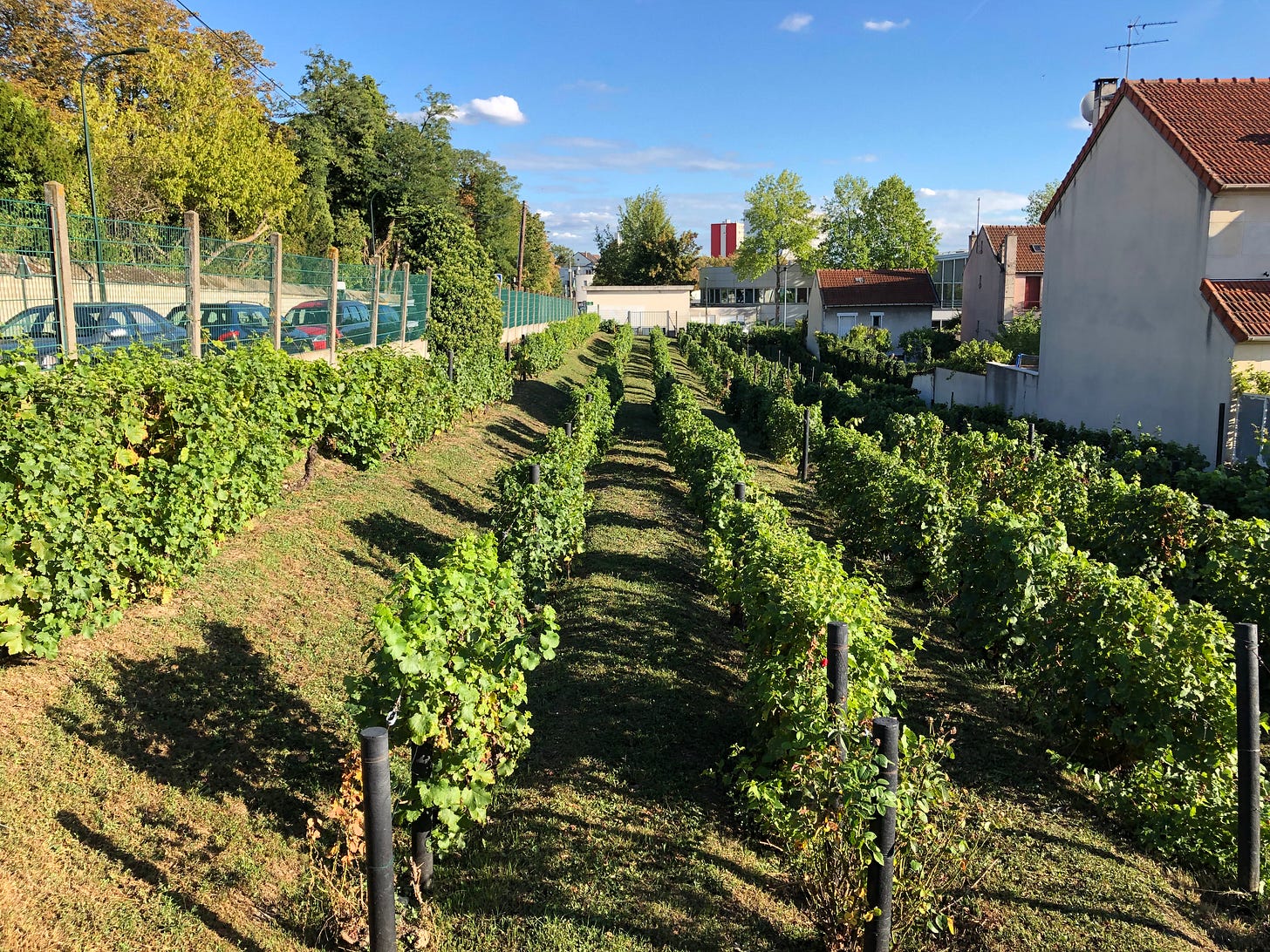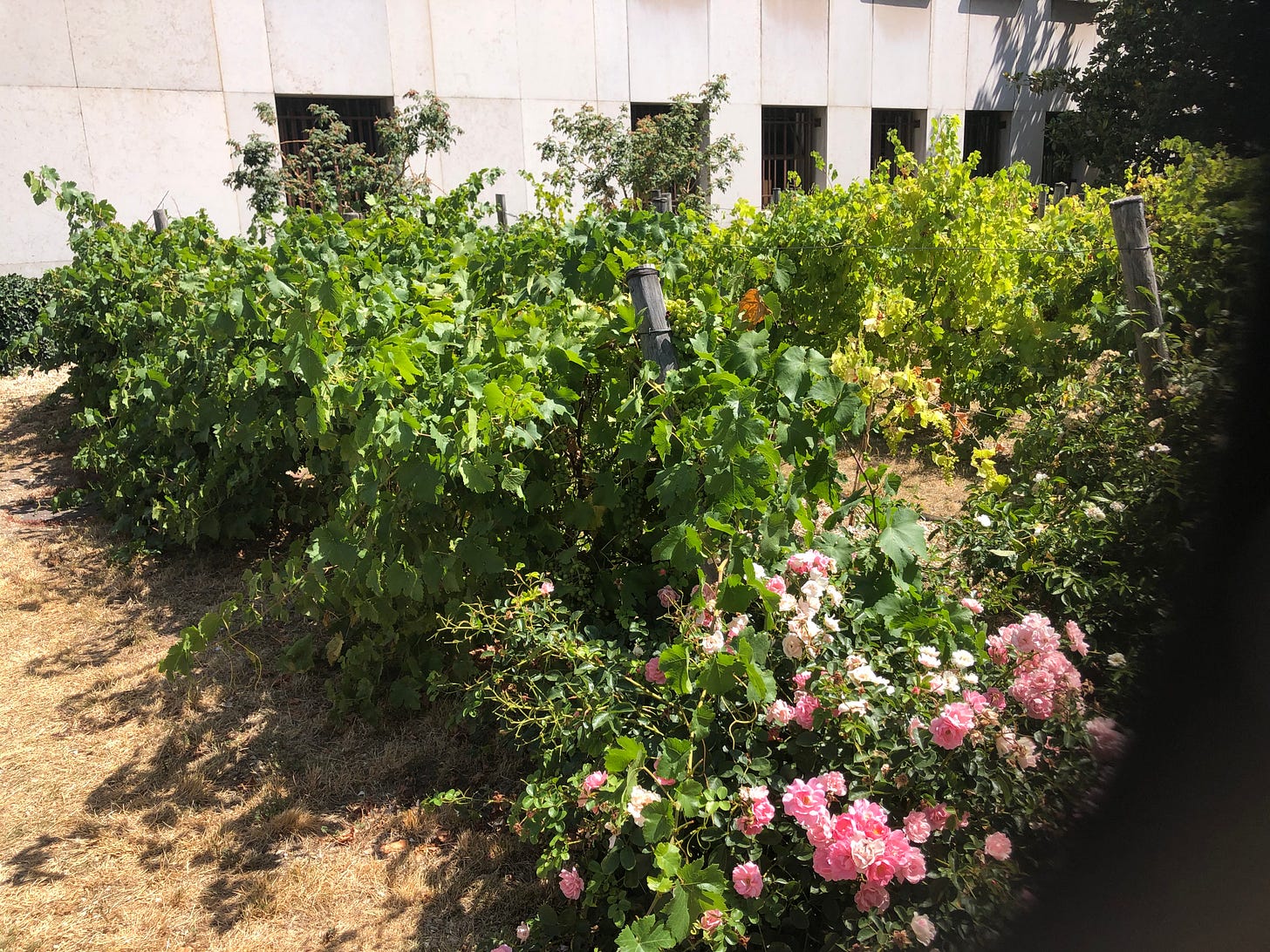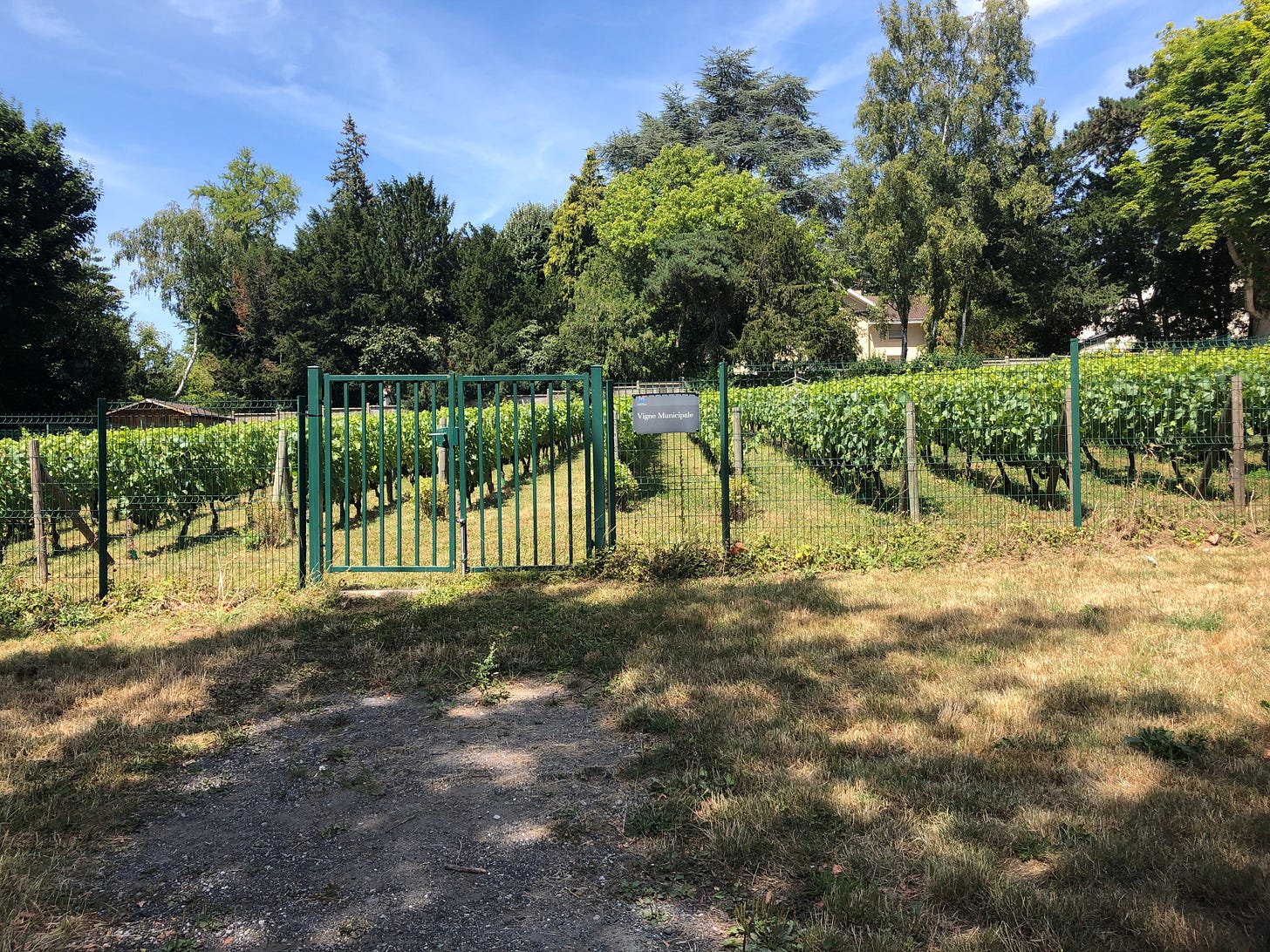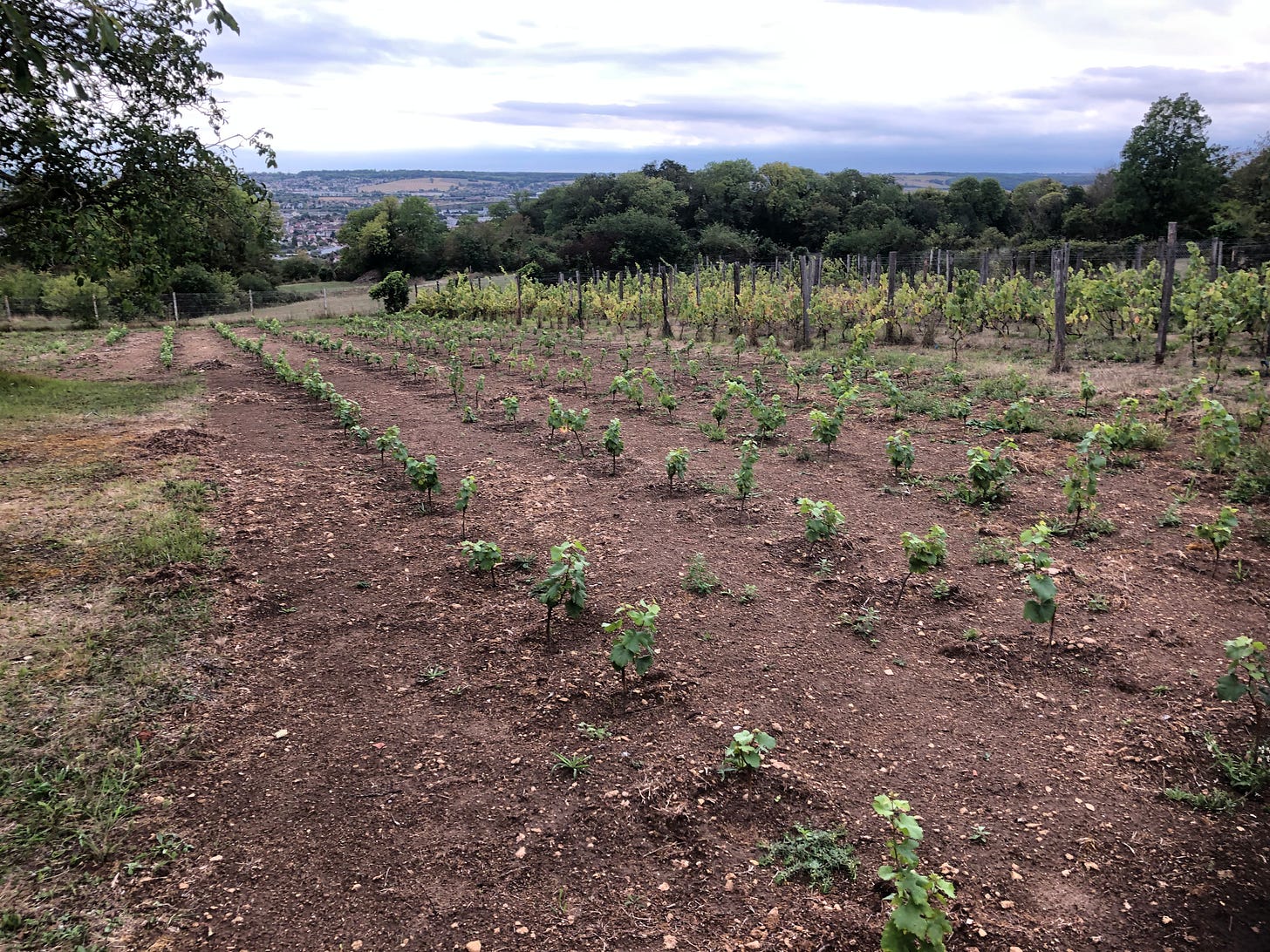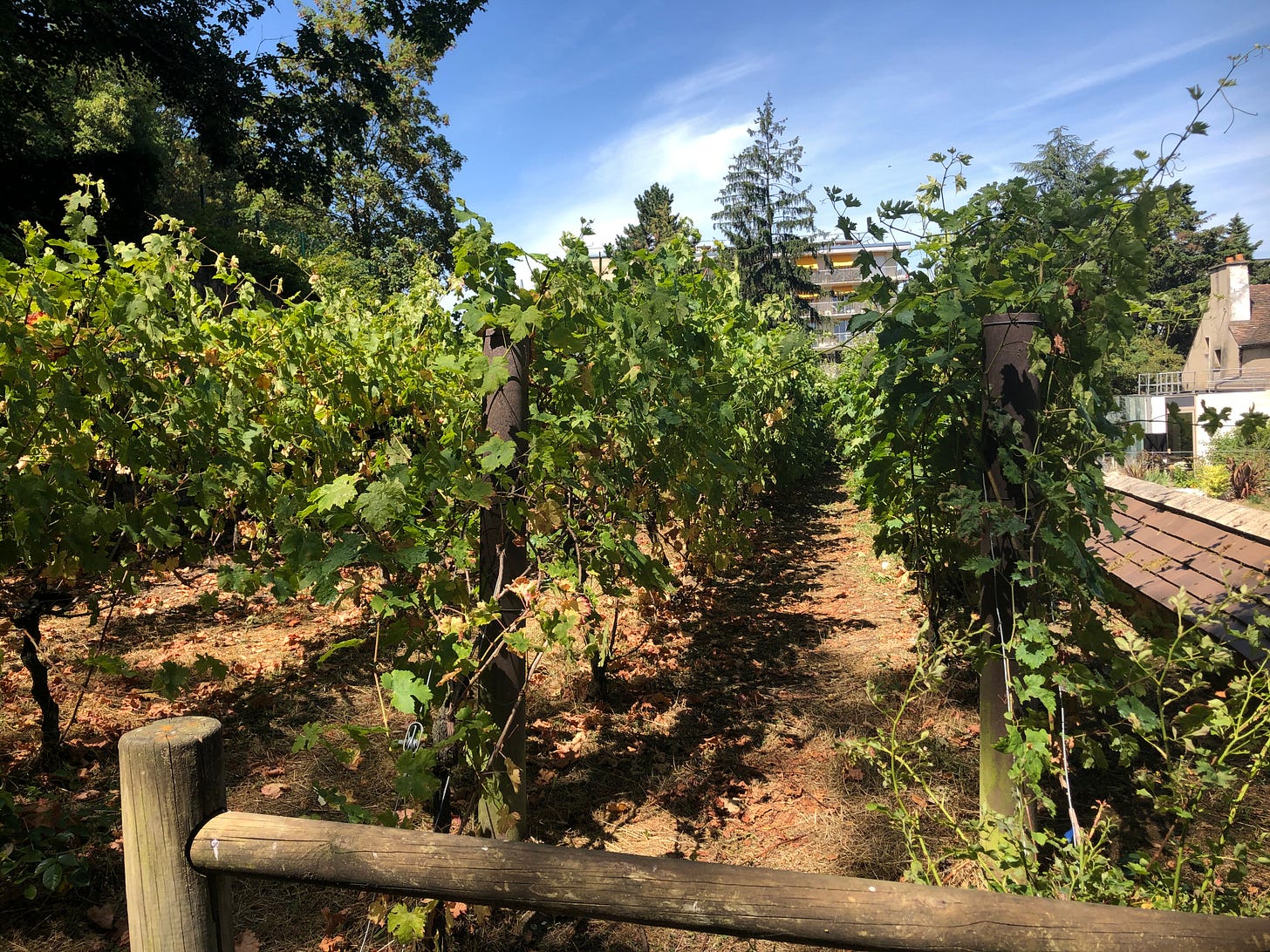An overview of IDF vineyards (part 4)
Municipal, associative, heritage
This is the last of a four-part series on the (mostly) non-commercial vineyards I visited in the summer of 2020. I got around by bike to visit the vineyards closest to Paris, thankfully, and by car to visit those further afield. I say thankfully because driving around in the suburbs of Paris, even in the month of August when Parisians have left the city for the beach, is rarely pleasant.
Nevertheless, It was a fun quest that made me far more familiar with the dense suburban mosaic that surrounds the capital than I might have ever intentionally sought. Although this was mostly August, traffic could come to a standstill and any sense of nature’s bounty would fade away amidst the acrid stench of exhaust fumes.
But what was revelatory about this adventure was the vine’s persistence, tentative though that might seem, in this region of France that was once the largest vineyard region in the world. The desire, the commitment, the attachment to maintaining the historical role the vine has played throughout the Île-de-France is a testament to its symbolic role as both a source of pleasure, inspiration, and culture, while also being a source of revenue.
Bagneux - Clos des Brugnauts - I recall walking about on the other side of the town from where these vines are located, imagining they were there. When I did find them, stuck between a street and a suburban allotment, I was struck by the determination these vines represent - the pride expressed in maintaining ties with the city’s viticultural past. And along with that, a sense of pathos in their being so obviously reduced, emblematic rather than truly productive.
Bagneux is a town with a long wine-making tradition, which saw its last vineyard disappear in 1965, but has now reconnected with its past by reintroducing young Sauvignon and Semillon vines to the ‘Clos des Brugnauts’. The wine from Bagneux won gold medals in 1996 and 1997. Every year, the grape harvest in September is celebrated with a large public festival. (2nd paragraph are notes translated from the city website)
Bougival - The vines of Bougival overlook the town on a steep plot of land. The aim of the association that is responsible for their care is to “preserve and renovate the wine-growing heritage and landscape, and revive a tradition; revitalise wine-growing and vineyard maintenance in Bougival by encouraging local residents to rediscover the vineyards; restore the vineyards, exchange expertise with other associations; promote meals and festivities”.
Boulogne Mairie - The vine’s capacity to hide in plain view is sometimes baffling. When going to visit this vineyard, I spoke to a police officer entering the police precinct 50 metres away from the vineyard who had no idea of where it was, even though it was entirely visible from where he stood. He must have passed in front of it hundreds of times, but was quite unaware of its presence.
In 2000, due to development work carried out in the basement of the town hall, areas around the town hall of Boulogne-Billancourt were torn up. Seizing the opportunity for a new plantation, the plot to the left of the main entrance was replaced by a vineyard, initially set up on a temporary basis, as part of an educational exhibition entitled ‘Boulogne-Billancourt Grandeur Nature’. The originality and success of this event encouraged the city to keep it.
It is planted to four table grape varieties: Alphonse Lavallée, Golden Chasselas from Fontainebleau, Hamburg Muscat, and Perle de Csaba, a vine with small clusters of golden table grapes
These same varieties of grapes now adorn the pergola of the family gardens of the Pont de Sèvres. Just like vineyard rows seen in various regions of France, the heads of the rows are planted with rose bushes - Rosa polyantha ‘Orleans Rose’, Rosa polyantha ‘Yvonne Rabier’, Rosa Vent d’Eté Korlanum.
Traditionally, this was like the canary in the coal mine, indicating in advance the diseases about to strike the vines so they could be treated in time. Strips of grass have been planted with purple and yellow crocuses, recalling the decorative patterns of the 1930s. Some years, a harvest is carried out in association with the children of the recreation centre. These vines have thus assumed an integral role in the gardens of the Town Hall, adding a social dimension to their presence as a botanical embellishment.
Champigny sur Marne - This vineyard is evidence of a long tradition of wine-making in Champigny dating back to the 13th century, when the first open-air cafés on the banks of the Marne served Champigny wine. Gradually, during the 19th century, local production disappeared due to disease and pressure from housing development. The wine of Champigny at the time was known for being a little sour, but inexpensive and well-liked by Parisians who came to the banks of the Marne to take advantage of the lower prices, which were not subject to the octroi tax.
In the early 2000s the town wanted to revive this tradition, and the project was featured in an article in “Champigny Notre Ville”. It was after this article that volunteers came forward and the association was founded. In collaboration with the department's technical services, the vineyard was established in the departmental park on six terraced levels, sloping down from Rue du Monument towards the RD4. The vats were installed in the former park keeper's house. The town hall provided a small financial contribution to purchase tools. 850 Pinot Noir vines were planted and the first vintage was produced four years later. Since then, between 50 and 400 bottles of wine have been produced each year. Today, there are around twenty community vineyards in the Val de Marne. (text translated and edited from smurl.fr/9jaeh)
Chaville - There are two municipal vineyards planted in Chaville in memory of the time when viticulture was one of the town’s main activities. The municipal vineyard of the former Academy of Fine Arts on rue Paul Vaillant-Couturier near the Rive Droit RER station, is located behind the Maison de l'Enfance et de la Jeunesse. This vineyard, planted to Chardonnay, has some 700 vines and is managed by officers from the parks and gardens department of the Chaville area who oversee its maintenance, from pruning to harvest, in collaboration with children from recreational centres.
The vinification is entrusted to the association ‘Vivre à Chaville’ and the wine produced is called ‘Chavignon’ (a contraction of ‘Chaville’ and ‘Sauvignon’, even though the grape is Chardonnay…), awarded in 1998 with a bronze medal at the Symposium d'Île-de-France. It exists in white (dry, slightly acidic) and in red (aromas of pinot predominantly characteristic of red fruits) and can be tasted at local events.
The municipal vineyard on the Rue de la Resistance is also managed by the ‘Vivre à Chaville’ association and was planted in 1989. It is comprised of 440 vines of Gamay and Pinot Noir. Located off the rue de la Resistance, just below the SNCF line (Paris-Saint-Lazare), it is some 200 metres from the other Chaville vineyard. Like the first vineyard, the harvest is intended to produce Chavignon.
Even though it was an important element of agricultural society in the Middle Ages, viticulture in Chaville never achieved the heights it did in neighbouring towns like Suresnes, Issy, Clamart or Meudon.
Follainville - Patrick Brico, president of the association of the communal vines of Follainville showed me around the vineyard planted to Pinot Noir with varietals that are not resistant to calcium so the vineyard has suffered. Looks rather sad. Beautiful press in the caves of the former Château de Condorcet. Chai also in the château caves, but too cold for vinification. Excellent tomatoes.
Issy les Moulineaux - The collection of Chasselas and Chardonnay grapes planted on the western side of the Botanical Gardens off the rue des Montquartiers in Issy les Moulineaux are also accessible on foot via the ‘Chemin des Vignes’ off the Avenue de Verdun. This vineyard is a tribute to Issy’s long wine history and the powerful brotherhood of winegrowers dedicated to Saint-Vincent who were in charge of a vineyard area that covered 76% of the cultivated land during the time of its greatest prosperity. This activity has long contributed to Issean fame, coming to an end with the First World War.
Today, agents of the parks and gardens service of Issy-les-Moulineaux lend a hand to cut and prune the neighbouring vines of the Saint-Vincent brotherhood with the wine merchant Yves Legrand (whose cellars are on the Avenue de Verdun), in the presence each year of children of a class from Issy, specially invited for the harvest. They also design the labels of the bottles.
The wine, which has been likened by some to wines of the Maconais, is available for sale at Yves Legrand’s ‘Chemin des Vignes’ wine cellar. Profits from the sale of the wine are given to the association of the Confrérie Saint-Vincent d’Issy-les-Moulineaux.
Meudon - Le Clos Rabelais - It was in 1994 that the wine tradition resumed in Meudon after its extinction in 1939. The entrance to the vineyard is at 11, rue des Pierres located in the upper garden of the Meudon Museum of Art and History. The ‘Clos Rabelais’ includes 450 vines; 250 vines of Cabernet Franc and 200 vines of Cabernet-Sauvignon.
It is named after François Rabelais, who was parish priest here from 1551 to 1553 and one of the city's most famous guests. Rabelais’ statement that, “wine is the most civilized thing in the world” is affirmed here by the elegant beauty and sculptural art collection of the park that hosts the vineyard.
The grape harvest is carried out with the children of the schools of Meudon in mid-October, who crush the grapes barefoot. On the occasion of these harvests, the brotherhood of the Clos Rabelais inducts various personalities, reviving the memory of the great dynasties that ensured the notoriety of the wines of Meudon. Over the centuries, vineyards spread over several dozen hectares and the winegrowers played an essential role in the life and management of the town. The municipal archives reveal, for example, that in 1817 there were 114 winegrowers in Meudon.
The vines, planted like an amphitheatre over the two hillsides of the city, represented a significant economic windfall and had a very good reputation. At the time, Parisians did not hesitate to come on Sundays and public holidays to consume the ‘petit vin de pays’ (the unpretentious local wine). It was therefore logical to perpetuate this wine tradition, which died out in the middle of the 20th century.
Which is why the Confrérie du Clos Rabelais took up the torch in 1994. On the 500th anniversary of the birth of François Rabelais, 450 vines were planted in the garden of the museum of art and history. Since then, the Confrérie du Clos Rabelais have invited members of other brotherhoods from Île-de-France and Champagne to help celebrate and promote their wine.
Montesson - Le Clos Des Vieilles Vignes - The stated objectives of this municipal vineyard are to revive and communicate the wine-growing traditions of the municipality. To cultivate the vineyard using traditional and experimental methods, produce and bottle wine, organise festive events every year in a friendly atmosphere, and share moments of conviviality: grape harvest, etc.
Osny - The vines are in the middle of a suburb where the association Les Amis de Grouchy cultivate 269 vines of chardonnay, planted in 2011. Their stated goal is to “promote multicultural activities and events and highlight the local heritage in Osny.”
Sannois - Wine has played a major role in the life of Sannois since the Middle Ages. In the 13th century, Sannois produced 30,000 litres of wine for the Abbey of Saint-Denis, which was one of the largest vineyards in Europe.
In 1870, the Sannois wine estate covered 223 hectares and half of the town's inhabitants worked there. In the 19th century, it disappeared, falling victim to disease (phylloxera, etc.), urbanisation and competition from other wines, mostly from the south of France.
Planted in 2003, the vineyard consists of 2,049 Chardonnay and Pinot Gris vines. Some of the vines were planted by children from the town's leisure centres.
All stages of wine production, from vine cultivation and vinification to bottling in the cellar and storage, are carried out entirely by green space workers on municipal land. The Centre d'aide par le travail (work assistance centre) also participates in its maintenance by clearing the land.
The vineyard is at the heart of a range of educational and cultural activities. It is an educational tool for the town's schools and a resource for research and historical activities linked to the mill's activities. (text adapted from the city of Sannois’ website)
Sceaux - Clos Renaudin - There is nothing left of the Clos Renaudin, though there are vines on either side of the entrance to the Trianon Cinema at #5 rue Marguerite Renaudin.
Thank you for letting me into your world and for reading the Paris Wine Walks Substack. Your support is invaluable as are your comments, suggestions, critiques, dreams, thoughts and remembrances. A little encouragement goes a long way, so please consider a paid subscription, which need cost no more than (a cheap) glass of wine per week. Or, book a wine walk!
My book, ‘The Hidden Vineyards of Paris’ (reviewed in Jancis Robinson’s wine blog, the Wine Economist, National Geographic Traveler UK, UK Telegraph) is available for purchase via our website and at anglophone bookshops and wine shops in Paris. You can also find it at the Musée de Montmartre and the Librairie Gourmande.
Wine Walks & Tastings!
Operating throughout the summer
Discover the real story of Paris by joining any one of our walking tours, the only natural wine tours in Paris that include vineyard visits!

